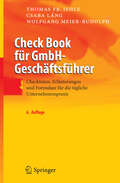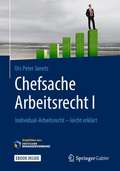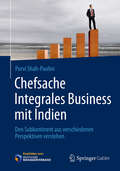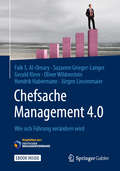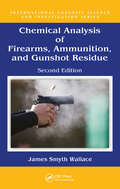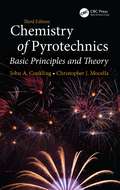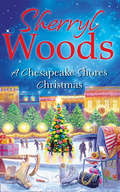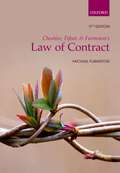- Table View
- List View
Cheating: Ethics in Everyday Life
by Deborah L. RhodeCheating is deeply embedded in everyday life. The costs of the most common forms of cheating total close to a trillion dollars annually. Part of the problem is that many individuals fail to see such behavior as a serious problem. "Everyone does it" is a common rationalization, and one that comes uncomfortably close to the truth. That perception is also self-perpetuating. The more that individuals believe that cheating is widespread, the easier it becomes to justify. Yet what is most notable about analysis of the problem is how little there is of it. Whether or not Americans are cheating more, they appear to be worrying about it less. In Cheating, eminent legal scholar Deborah L. Rhode offers the only recent comprehensive account of cheating in everyday life and the strategies necessary to address it. Because cheating is highly situational, Rhode drills down on its most common forms in sports, organizations, taxes, academia, copyright infringement, marriage, and insurance and mortgages. Cheating also reviews strategies necessary to address the pervasiveness and persistence of cheating in these contexts. We clearly need more cultural reinforcement of ethical conduct. Efforts need to begin early, with values education by parents, teachers, and other role models who can display and reinforce moral behaviors. Organizations need to create ethical cultures, in which informal norms, formal policies, and reward structures all promote integrity. People also need more moral triggers that remind them of their own values. Equally important are more effective enforcement structures, including additional resources and stiffer sanctions. Finally, all of us need to take more responsibility for combatting cheating. We need not only to subject our own conduct to more demanding standards, but also to assume a greater obligation to prevent and report misconduct. Sustaining a culture that actively discourages cheating is a collective responsibility, and one in which we all have a substantial stake.
Cheating and Deception
by J. Bowyer Bell Barton WhaleyCheating and deception are terms often used but rarely defined. They summon up unpleasant connotations; even those deeply involved with cheating and deception rationalize why they have been driven to it. Particularly for Americans and much of Western civilization, official cheating, government duplicity, cheating as policy, and conscious, contrived deception, are all unacceptable except as a last resort in response to threat of extinction. As a distasteful tool, deception is rarely used to achieve national interests, unless in relation to the deployment of military force. As an area of study, it has by and large been ignored.Intrigued by attitudes toward cheating and deception, the authors decided to analyze its roots, structure, and process. They asked fundamental questions: are there categories of deception, general steps in the process of deception, and ways to evaluate its results across time and in different modes? The book that results is a typology of kinds of deception, beginning with military deception, but extending into other categories and stages.In his introduction to this new edition, Bell outlines how the book came to be written, describes the mixed emotions toward the subject displayed by govenmental and nongovernmental funding sources, and speculates about its critical and commercial reception. He discusses widespread new interest in the subject, the research that has been undertaken since this book was first published, and its limitations.This book provides a general overview of this complex subject, creating a framework for analysis of specific instances of cheating or deception. It will be of particular interest to political scientists, those interested in military affairs and strategy, and psychologists. The general reader will find the book written with a light touch, drawing examples of cheating and deception in the pursuit of love and money. The specialist reader will be intrigued by its broad-ranging examples drawn from policy and politics,
Cheating and Deception
by J. Bowyer Bell Barton WhaleyCheating and deception are terms often used but rarely defined. They summon up unpleasant connotations; even those deeply involved with cheating and deception rationalize why they have been driven to it. Particularly for Americans and much of Western civilization, official cheating, government duplicity, cheating as policy, and conscious, contrived deception, are all unacceptable except as a last resort in response to threat of extinction. As a distasteful tool, deception is rarely used to achieve national interests, unless in relation to the deployment of military force. As an area of study, it has by and large been ignored.Intrigued by attitudes toward cheating and deception, the authors decided to analyze its roots, structure, and process. They asked fundamental questions: are there categories of deception, general steps in the process of deception, and ways to evaluate its results across time and in different modes? The book that results is a typology of kinds of deception, beginning with military deception, but extending into other categories and stages.In his introduction to this new edition, Bell outlines how the book came to be written, describes the mixed emotions toward the subject displayed by govenmental and nongovernmental funding sources, and speculates about its critical and commercial reception. He discusses widespread new interest in the subject, the research that has been undertaken since this book was first published, and its limitations.This book provides a general overview of this complex subject, creating a framework for analysis of specific instances of cheating or deception. It will be of particular interest to political scientists, those interested in military affairs and strategy, and psychologists. The general reader will find the book written with a light touch, drawing examples of cheating and deception in the pursuit of love and money. The specialist reader will be intrigued by its broad-ranging examples drawn from policy and politics,
Check Book für GmbH-Geschäftsführer: Checklisten, Erläuterungen und Formulare für die tägliche Unternehmenspraxis
by Thomas F. Jehle Csaba Láng Wolfgang Meier-RudolphDas Check Book bietet dem Geschäftsführer praktische Orientierungshilfen für schnelles und sicheres Arbeiten. Kern des Handbuchs sind Checklisten für alle wesentlichen GmbH-Verwaltungstätigkeiten von A wie Abberufung bis Z wie Zweigniederlassung. Sie werden ergänzt durch Muster, Verträge, Formulare und Brieftexte für die effektive Bearbeitung der verschiedensten Vorgänge in der GmbH.
Check Book für GmbH-Geschäftsführer: Checklisten, Erläuterungen und Formulare für die tägliche Unternehmenspraxis
by Thomas F. Jehle Csaba Láng Wolfgang Meier-RudolphDas Check Book bietet Geschäftsführern kleiner und mittlerer Unternehmen eine an der Praxis ausgerichtete Hilfe für schnelles und sicheres Arbeiten. Kern des Handbuchs sind Checklisten für alle wesentlichen GmbH-Verwaltungstätigkeiten von A wie Abberufung bis Z wie Zweigniederlassung. Dazu enthält der Band Muster-Verträge, -Formulare und -Briefe für die effektive Bearbeitung der verschiedensten Vorgänge. Kurze Aufsätze und Hinweise auf wichtige Quellen dienen der Vertiefung der zentralen Themen und Problemstellungen des Handbuchs.
Checkmate Corruption
by Arpinder Singh Vinay GarodiyaAbout the bookGrowth deterrents, such as fraud, bribery and corruption have the ability to cripple economies and place regions under undue anxiety and turmoil. Governments and corporate entities agree that fraud, bribery and corruption are bad for business and society, and that decisive steps need to be taken to mitigate them. Markets are never static. New risks constantly emerge, and the matters that regulators and the public consider as inappropriate or fraudulent are evolving. It is therefore critical at this juncture to implement adequate safeguards and measures to evaluate and address risks around fraud and corruption.The book intends to bring a real and relevant representation of the market challenges faced by organizations, including American companies while running business operations in India. The constant battle between corruption and anti-corruption is like a game of chess, with two opposing sides pitted against each other. Chess, which incidentally has its origin pinned down in India, seems to be an apt way to depict this continued conflict in corporate India.
Chefsache Arbeitsrecht I: Individual-Arbeitsrecht - leicht erklärt (Chefsache Ser.)
by Urs Peter JanetzDas Chefsache-Buch unterstützt Arbeitgeber und leitende Angestellte mit wichtigen Informationen zu allen Themen des Individualarbeitsrechts. Weit verbreitet ist die Ansicht, dass „der Arbeitnehmer doch sowieso immer gewinnt“ und dass man als Arbeitgeber „ohnehin keine Chance vor Gericht hat“ hat. Doch das muss nicht sein – wenn man sich als Arbeitgeber mit der Thematik rechtzeitig beschäftigt und mit Augenmaß und Wertschätzung an die Materie herangeht. Dafür ist dieses Buch ein hilfreicher Einstieg. Der Text verzichtet komplett auf juristische Fachsprache. Stattdessen vermittelt der Autor die Materie sehr kompakt, verständlich und humorvoll. Zahlreiche Beispielfälle und Info-Boxen verdeutlichen die Zusammenhänge. So werden die Leser schnell für die arbeitsrechtlichen Knackpunkte und Stolpersteine sensibilisiert. Im Anhang werden Mustertexte für einen Arbeitsvertrag, einen Aufhebungsvertrag und eine Abmahnung zur Verfügung gestellt.
Chefsache Integrales Business mit Indien: Den Subkontinent aus verschiedenen Perspektiven verstehen
by Purvi Shah-Paulini Peter BuchenauDas Buch aus der Chefsache-Reihe zeigt, dass es sich mit langfristigen Strategien und Geduld lohnt, in Geschäftsbeziehungen zu Indien zu investieren und diese aufrecht zu erhalten.Die integrale Sichtweise zeigt dabei die äußeren Einflussfaktoren, wie z.B. Politik und Geschichte, aber auch die inneren Einflussfaktoren, die zum einen von jedem Individuum abhängig sind, aber auch dem Umfeld, in dem das Individuum aufwächst und arbeitet. Mit dem Graves-Value-Modell wird dem Leser ein Werkzeug an die Hand gegeben, das den Wertewandel und die Denkweisen der deutschen und der indischen Kultur verdeutlicht. Damit bietet das Buch interessante und fundierte Einblicke und liefert wertvolle Markteintrittsstrategien für deutschsprachige Unternehmen.
Chefsache Management 4.0: Wie sich Führung verändern wird (Chefsache)
by Falk S. Al-Omary Suzanne Grieger-Langer Gerald Kleer Oliver Wildenstein Hendrik Habermann Jürgen LinsenmaierDas Buch aus der Chefsache-Reihe stellt die neuen Herausforderungen an das Management der Zukunft in den Blickpunkt. 6 Experte, alle mit großer Führungserfahrung, stellen sich den wichtigsten Fragen und beantworten, worauf es ankommt.
Chemical Analysis of Firearms, Ammunition, and Gunshot Residue (International Forensic Science and Investigation)
by James Smyth WallaceChemical Analysis of Firearms, Ammunition, and Gunshot Residue, Second Edition continues in the tradition of the popular first edition, filling the void in forensic texts on the subject. While most books on firearms focus solely on the physical aspects of firearms, this book addresses forensic issues relating to the chemical aspects of firearms and ammunition. It draws on the latest published literature including books, scientific papers, technical reports, manufacturer’s literature, newspaper articles, and personal observations and research conducted by the author. This edition is fully updated, introducing the history and development of firearms and ammunition including advances in the chemical analysis of them. Several changes in primer compositions and the particle classification system are addressed with new techniques added on evidence collection and testing methods. Coverage details chemical aspects of forensic firearms casework with particular emphasis on the detection of gunshot residues (GSR), firearm discharge residues (FDR), and cartridge discharge residues (CDR) on a suspect’s skin and clothing surfaces. Two new chapters have been added. One deals with unusual firearms case while the other summarizes a controversial, high-profile Australian case involving inorganic and organic gunshot residue, highlighting the dangers of incorrect forensic evidence and the increased need for careful training of forensic scientists. Fully updated to reflect the latest techniques and tests for particle and chemical classification Provides a complete history of firearms and ammunition development as well as advances in the chemical analysis involved in forensic firearm casework Features a one-of-a-kind chapter on processing suspects, a crucial component in many firearms and explosives residue cases The book will serves as a useful to forensic chemists, investigators, ballistics experts, among other professionals serving in a variety of forensic disciplines.
Chemical Analysis of Firearms, Ammunition, and Gunshot Residue (International Forensic Science and Investigation)
by James Smyth WallaceChemical Analysis of Firearms, Ammunition, and Gunshot Residue, Second Edition continues in the tradition of the popular first edition, filling the void in forensic texts on the subject. While most books on firearms focus solely on the physical aspects of firearms, this book addresses forensic issues relating to the chemical aspects of firearms and ammunition. It draws on the latest published literature including books, scientific papers, technical reports, manufacturer’s literature, newspaper articles, and personal observations and research conducted by the author. This edition is fully updated, introducing the history and development of firearms and ammunition including advances in the chemical analysis of them. Several changes in primer compositions and the particle classification system are addressed with new techniques added on evidence collection and testing methods. Coverage details chemical aspects of forensic firearms casework with particular emphasis on the detection of gunshot residues (GSR), firearm discharge residues (FDR), and cartridge discharge residues (CDR) on a suspect’s skin and clothing surfaces. Two new chapters have been added. One deals with unusual firearms case while the other summarizes a controversial, high-profile Australian case involving inorganic and organic gunshot residue, highlighting the dangers of incorrect forensic evidence and the increased need for careful training of forensic scientists. Fully updated to reflect the latest techniques and tests for particle and chemical classification Provides a complete history of firearms and ammunition development as well as advances in the chemical analysis involved in forensic firearm casework Features a one-of-a-kind chapter on processing suspects, a crucial component in many firearms and explosives residue cases The book will serves as a useful to forensic chemists, investigators, ballistics experts, among other professionals serving in a variety of forensic disciplines.
Chemical Criminalistics
by A. Maehly L. StrömbergIn recent years, a number of textbooks on forensic science have been published, most of them directed to two groups, viz. the students of forensic science, and the customers so to say, (prosecutors, police officers, judges, defense lawyers). In this book, while covering fundamental concepts, we try to go a little further and address also active workers in the field of forensic chemistry. This is mainly achieved by relatively nu merous literature references. We hope that they may assist the forensic chemist in penetrating further into the subjects covered in this volume. At the end of most chapters there are examples of actual cases handled at the Swedish National Laboratory of Forensic Science. Many of these cases could, no doubt, have been investigated in greater detail, but they reflect the compromises often necessary for achieving a reasonable turnover. Some parts of the book are quite strongly colored by the personal opinions of the authors. We felt that these passages will give a little more life to the text than in other treatises of a more objective, but possibly duller character. The authors welcome all constructive criticism which will help to improve the book, should there be a second edition.
Chemikalienregulierung und Innovationen zum nachhaltigen Wirtschaften (Nachhaltigkeit und Innovation)
by Bernd Hansjürgens Ralf NordbeckDie europäische Chemikalienregulierung steht auf dem Prüfstand. Mit dem kontrovers diskutierten REACH-System soll einerseits ein Beitrag zu einem verbesserten Gesundheits-, Umwelt- und Verbraucherschutz geleistet werden, andererseits sollen Innovationen in den europäischen Volkswirtschaften nicht behindert werden, um wirtschaftliche Entwicklung und Wohlstand zu ermöglichen. Der vorliegende Band analysiert die Bestimmungsgründe für Innovationen zum nachhaltigen Wirtschaften, untersucht die Effektivität und die Innovationswirkungen der bestehenden Chemikalienregulierung sowie des neuen REACH-Systems, diskutiert Verfahren der Risikobewertung und entwickelt Vorschläge zu alternativen Regelungsformen. Das Buch richtet sich sowohl an Wissenschaftler und Studierende, die an Innovationstheorie interessiert sind, als auch an Praktiker im Bereich der europäischen Chemikalienpolitik.
Chemistry and Food Safety in the EU: The Rapid Alert System for Food and Feed (RASFF) (SpringerBriefs in Molecular Science)
by Salvatore Parisi Caterina Barone Ramesh Kumar SharmaThis Brief provides a general description of the European Rapid Alert System for Food and Feed (RASFF). It describes the RASFF approach on the legal level and with reference to notification procedures, including also new tools, which were launched in 2014: iRASFF and the RASFF Consumer Portal. In an introduction, the present status of the RASFF, which had originally been introduced in 1979, is briefly reviewed. It is described as the main basis of modern food policy in Europe, enabling member countries to take rapid corrective actions on the one hand, and to perform statistically reliable analyses of food-related hazards on the other hand. One chapter contains a statistical evaluation of RASFF notifications in general, and specifically with regard to chemical contaminants, including also allergens. In another chapter, reasons for rejections of food and feed at the European borders are analyzed in selected case studies. The Brief provides an easy description for the chemical dangers and contaminants it is referring to, outlining the names, properties, uses and importance in the food and feed industry, toxicological effects, and contamination sources. The last chapter offers an outlook on the future of the RASFF and possible expectations.
Chemistry and Hygiene of Food Additives (SpringerBriefs in Molecular Science)
by Pasqualina Laganà Emanuela Avventuroso Giovanni Romano Maria Eufemia Gioffré Paolo Patanè Salvatore Parisi Umberto Moscato Santi DeliaThis brief addresses important aspects of food additives. Through four chapters, the authors describe the chemistry of food additives, the regulatory classification of additives on a large-scale, the risks involved in using chemicals for food preparation – including implications this has on food hygiene, and case-study examples taken from the dairy industry. More specifically, chapter one provides a list of the technological purposes of food additives defined for European use; chapter two explains the 'General Standards for Food Additives' (Codex Alimentarius Commission) which is a harmonised, workable and indisputable international standard; chapter three describes the use of selected food additives in the dairy sector, particularly with relation to the production of yoghurt products; and chapter four addresses the impact of additives on human health. This brief is of interest to researchers working in the area of food production and international regulation, both in academia and industry.
Chemistry and Hygiene of Food Gases (SpringerBriefs in Molecular Science)
by Pasqualina Laganà Giovanni Campanella Paolo Patanè Maria Assunta Cava Salvatore Parisi Maria Elsa Gambuzza Santi Delia Maria Anna ConiglioThis book focuses on the use of food gases in the food industry, their different applications and their role in food processing, packaging and transportation. Since these gases come into contact with food, they must comply with strict of labeling, purity and hygiene standards in order to ensure food safety.The book discusses various implications of food gases in the food chain, providing examples of how they can be used to limit food waste and losses. The first two chapters examine the classification and role of food gases in Europe, and the third chapter then explores the chemical and physical features of commonly used food gases in the food and food packing industries. The fourth chapter highlights the impact of food gases on human health due to their possible abuse and misuse. This book appeals to researchers and professionals working in food production and quality control.
Chemistry of Foods: Eu Legal And Regulatory Approaches (SpringerBriefs in Molecular Science)
by Daniele PisanelloThis book concerns the EU legal and regulatory framework relating to Chemicals in Food. It is divided in two parts: the first section offers an introduction to the European General Food Law with an analysis of EFSA (the European Food Safety Authority) and a description of main features of food safety-related regulations. The second part focusses on the legislation finding application concerning chemicals in food from different viewpoints, namely:- the REACH regulation;- the enzyme, flavorings and additive regulatory framework;- the matter of contamination and veterinary drugs;- the use of Food contact materials. The final chapter addresses several considerations relating to chemical hazards and crisis management, highlighting shortcomings and lessons from experience.
Chemistry of Pyrotechnics: Basic Principles and Theory, Third Edition
by Chris Mocella John A. ConklingThis book provides chemists with technical insight on pyrotechnics and explosives. It emphasizes basic chemical principles and practical, hands-on knowledge in the preparation of energetic materials. It examines the interactions between and adaptations of pyrotechnics to changing technology in areas such as obscuration science and low-signature flame emission. The updated third edition discusses chemical and pyrotechnic principles, components of high-energy materials, elements of ignition, propagation, and sensitivity. It offers heat compositions, including ignition mixes, delays, thermites, and propellants and investigates the production of smoke and sound as well as light and color.
Chemistry of Pyrotechnics: Basic Principles and Theory, Third Edition
by Chris Mocella John A. ConklingThis book provides chemists with technical insight on pyrotechnics and explosives. It emphasizes basic chemical principles and practical, hands-on knowledge in the preparation of energetic materials. It examines the interactions between and adaptations of pyrotechnics to changing technology in areas such as obscuration science and low-signature flame emission. The updated third edition discusses chemical and pyrotechnic principles, components of high-energy materials, elements of ignition, propagation, and sensitivity. It offers heat compositions, including ignition mixes, delays, thermites, and propellants and investigates the production of smoke and sound as well as light and color.
Chern on Dispute Boards: Practice And Procedure (Construction Practice Series)
by Cyril ChernChern on Dispute Boards examines the law of dispute boards and their development internationally, while also covering procedural topics that are of particular concern to those utilising dispute boards. It deals with advanced practitioner issues in the emerging law of dispute boards on an international scale, laying out their methods and methodology not only under the common law, but also under other legal systems such as Civil law and Shari’ah law. Excelling in describing the "how and why", this book also gives samples and/or forms of actual working dispute boards that any practitioner could use and adapt to their own needs. Readers of this this updated third edition will have explained to them the various international formats and types of dispute boards in use today and be brought up-to-date on the ever evolving law within the field. New to this 3rd edition is the extensive coverage of appeals from Dispute Board Decisions, the laws relative to appeals and the ICC, enforcement procedures and new forms and guidelines for the practitioner. This book guides the reader through the complexities of actual commercial and construction disputes and their successful resolution and also presents a way forward for the dispute board members themselves to administer actual dispute boards all over the world. It is therefore, the number one guide for construction lawyers, engineers and dispute board stakeholders worldwide.
Chern on Dispute Boards (Construction Practice Series)
by Cyril ChernChern on Dispute Boards examines the law of dispute boards and their development internationally, while also covering procedural topics that are of particular concern to those utilising dispute boards. It deals with advanced practitioner issues in the emerging law of dispute boards on an international scale, laying out their methods and methodology not only under the common law, but also under other legal systems such as Civil law and Shari’ah law. Excelling in describing the "how and why", this book also gives samples and/or forms of actual working dispute boards that any practitioner could use and adapt to their own needs. Readers of this this updated third edition will have explained to them the various international formats and types of dispute boards in use today and be brought up-to-date on the ever evolving law within the field. New to this 3rd edition is the extensive coverage of appeals from Dispute Board Decisions, the laws relative to appeals and the ICC, enforcement procedures and new forms and guidelines for the practitioner. This book guides the reader through the complexities of actual commercial and construction disputes and their successful resolution and also presents a way forward for the dispute board members themselves to administer actual dispute boards all over the world. It is therefore, the number one guide for construction lawyers, engineers and dispute board stakeholders worldwide.
Chern on Dispute Boards: Practice and Procedure (Construction Practice Series)
by Cyril ChernChern on Dispute Boards examines the law of dispute boards and their development internationally, while also covering procedural topics that are of particular concern to those utilising dispute boards. It deals with advanced practitioner issues in the emerging law of dispute boards on an international scale, laying out their methods and methodology not only under the common law, but also under other legal systems such as Civil law and Shari’ah law. Excelling in describing the "how and why", this book also gives samples and/or forms of actual working dispute boards that any practitioner could use and adapt to their own needs. This updated fourth edition explains the various international formats and types of dispute boards in use today and brings readers up-to-date on the ever-evolving law within the field. The text guides the reader through the complexities of actual commercial and construction disputes and their successful resolution and also presents a way forward for the dispute board members themselves to administer actual dispute boards all over the world. This book is essential reading for construction lawyers, engineers and dispute board stakeholders worldwide.
Chern on Dispute Boards: Practice and Procedure (Construction Practice Series)
by Cyril ChernChern on Dispute Boards examines the law of dispute boards and their development internationally, while also covering procedural topics that are of particular concern to those utilising dispute boards. It deals with advanced practitioner issues in the emerging law of dispute boards on an international scale, laying out their methods and methodology not only under the common law, but also under other legal systems such as Civil law and Shari’ah law. Excelling in describing the "how and why", this book also gives samples and/or forms of actual working dispute boards that any practitioner could use and adapt to their own needs. This updated fourth edition explains the various international formats and types of dispute boards in use today and brings readers up-to-date on the ever-evolving law within the field. The text guides the reader through the complexities of actual commercial and construction disputes and their successful resolution and also presents a way forward for the dispute board members themselves to administer actual dispute boards all over the world. This book is essential reading for construction lawyers, engineers and dispute board stakeholders worldwide.
A Chesapeake Shores Christmas: Santa, Baby (A Chesapeake Shores Novel #4)
by Sherryl WoodsHome, heart and family. Sherryl Woods knows what truly matters. After years apart, Mick and Megan O’Brien are finally ready to make it official…again. Most of their grown-up children couldn’t be happier about their rekindled love and impending marriage this Christmas. Only Connor is a holdout.
Cheshire, Fifoot, and Furmston's Law of Contract
by MP FurmstonCheshire, Fifoot & Furmston's Law of Contract remains one of the leading textbooks on contract law more than 70 years after the publication of its first edition. It combines a clear and authoritative account of the principles of the law of contract with thought-provoking analysis and insights. - The clarity of the narrative and lucid writing style helps to bring understanding of complex issues to a wider readership - Each topic is clearly signposted with summaries, introductory text and sub-headings for ease of navigation throughout the book - Numerous references to additional primary and secondary sources take the reader even further into the subject



